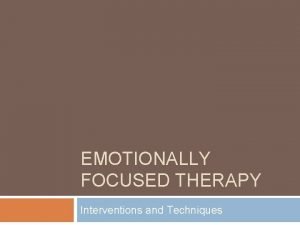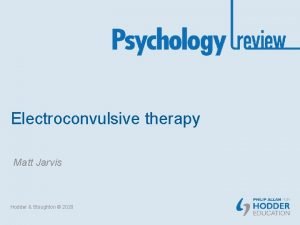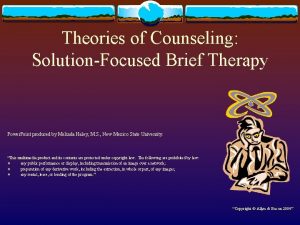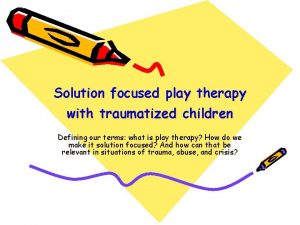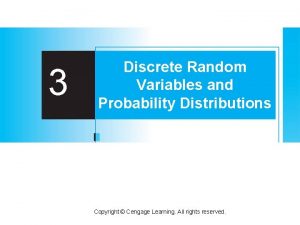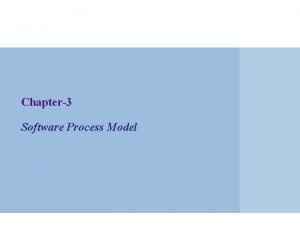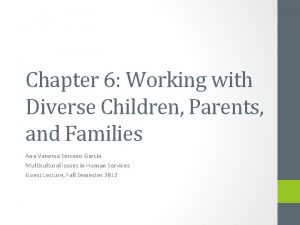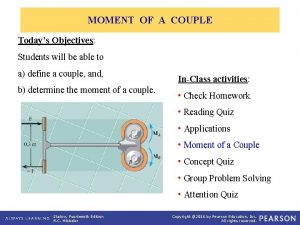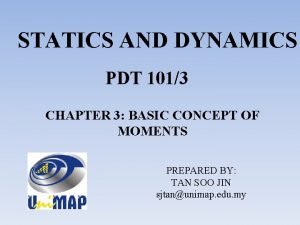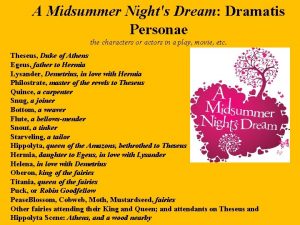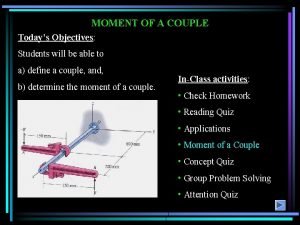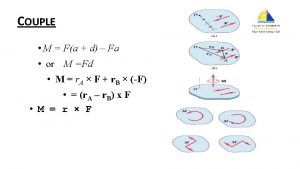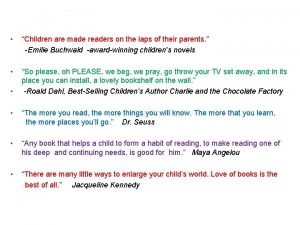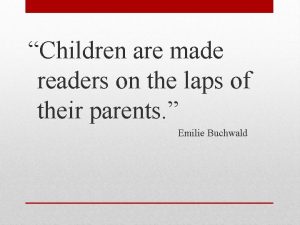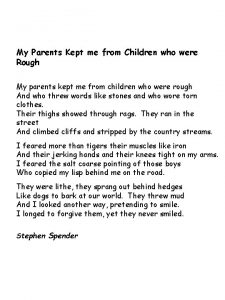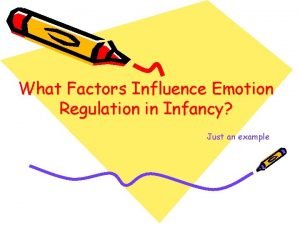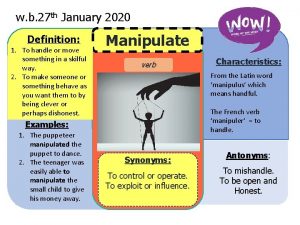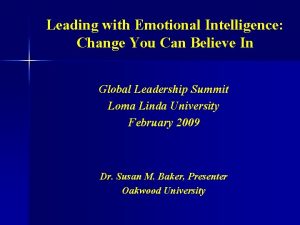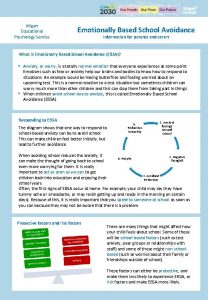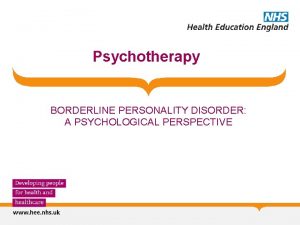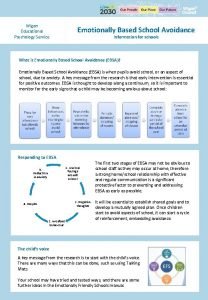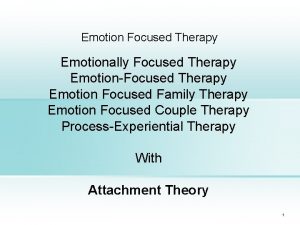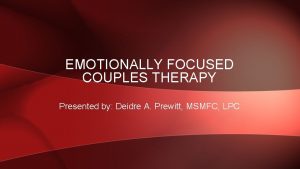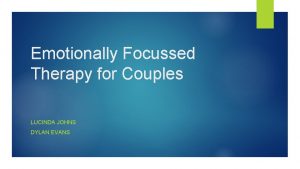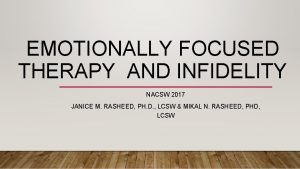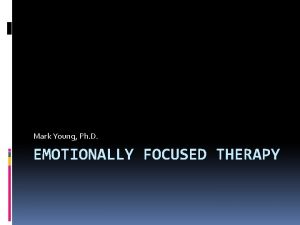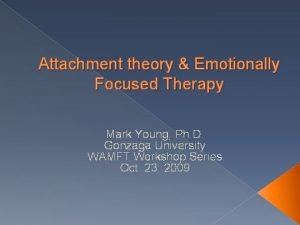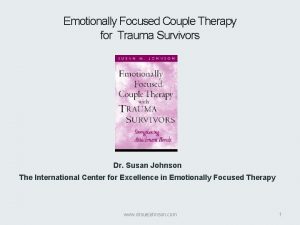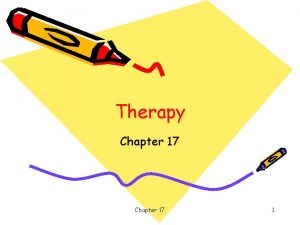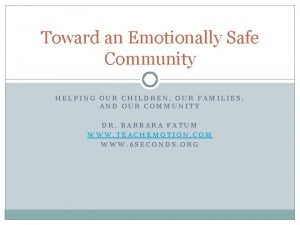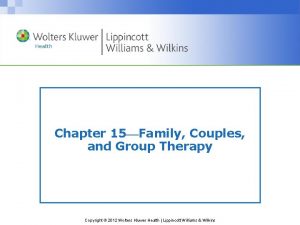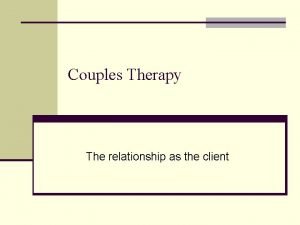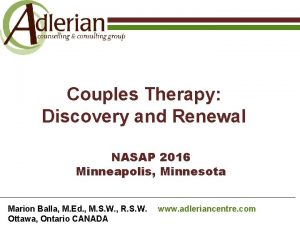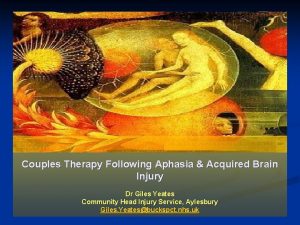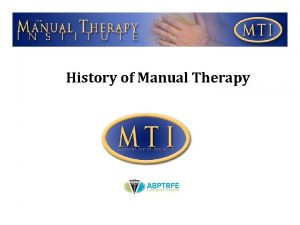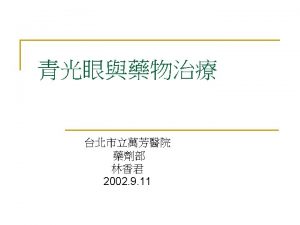Emotionally Focused Couples Therapy with Parents of Children






































- Slides: 38

Emotionally Focused Couples Therapy with Parents of Children on the Autism Spectrum A Research Study DAFT Conference 18 th May 2018 Sarah Mc. Connell, M. A. , LMFT-S, LPC-S, UKCP Registered Psychotherapist

Agenda • • • Autism and how it affects couples Typical Stressors and Typical Problems Our research – Goals and Overview Study I Results Study II Results Research Challenges/Limitations

Autism & Couples

Why did we do the study? Dr William Bolman (ASA's 37 th National Conference on Autism Spectrum Disorders (July 13 -15, 2006) “There were so many demanding issues to deal with that inevitably normal family structure and balance became focused around the needs of the child with autism. Thus, marital relationship time disappeared and with it went the sharing, mutuality, and working out of joint issues that promote marital survival. In the absence of this essential aspect of two people sharing a life and creating a joint future, parents found themselves falling back on traditional role responsibilities. Dads went to work and earned money while moms stayed at home and tried to become experts on autism! The inevitable result was that of growing apart,

“……. sometime around age five to ten years the marital deficits and inadequacy of the traditional roles began to show evidence of strain and even open dissatisfaction. Dads became frustrated at the demands of their wives to “play with” a son or daughter who didn't know how to play, and moms became frustrated at the lack of involvement of their mates. In retrospect, this appears to be the time that the existing intramarital separation starts the couples on a path towards formal separation and divorce. ” Bolman, 2006

Typical Stressors & Problems

Typical Stressors Ramish, 2010 • • • Obtaining a correct diagnosis Problem behaviors (aggressive and violent) Financial hardship Unpredictability about the future Negative reactions from society and family members Frustration (missing “normal” way of life) Spouse is on a different “wavelength” Difficult access to professionals and agencies Depression and anxiety in both partners

Study I: Methodology • A thematic analysis was conducted to identify unique themes linking individual couple reports of relational distress to unique stressors associated with raising a child with an ASD. • Video recordings from the first three sessions of each couple were collected and transcribed • The transcripts were coded by two graduate students not associated with providing treatment • The coders made note of unique recurring themes, patterns, and references that captured the experience of parenting a child with an ASD diagnosis. • These codes were distilled into themes and a list of final themes were identified through coder consensus.

Study I Results 1. The woman often feels alone and responsible for autistic child (medical treatment and care taking) 2. Husband emotionally unavailable 3. Relationship put on shelf - Loss of connection 4. Survival Mode • Diagnosis changed everything - immediacy • Couple relationship defined by autistic child • Exhaustion

Study I Results 5. Wanting a more mature relationship 6. It’s now or never 7. Constant state of anxiety 8. Need to mourn 9. Us against the world - Isolation from everyone - No one would volunteer for this - No one understands what they’re going through - Lack of social support

Brief Overview of EFT

Overview of EFT Authors Dr. Leslie Greenberg Psychologist, York University, Toronto. Mainly EFT w/individuals. Leading process researcher. EFT w/ind. empirically validated. Dr. Susan Johnson Psychologist, University of Ottawa. Student of Les in early 1980’s. Interested in couples therapy and attachment theory. Leading proponent of EFT use with couples. BB

Major Reviews • Empirically Supported Couple Therapy EFT is one of only two empirically supported treatments for couples therapy (Snyder, Castellani, & Whisman, 2005). • Meta-analysis EFT studies demonstrate a 70 – 73% rate of improvement and an effect size of 1. 31 for the four outcome studies composing the EFT meta-analysis (Johnson, 2003). • Robust Approach EFT applied to a variety of treatment conditions: Depression, Post-partum Depression, Chronic Illness, Eating Disorders, Infidelity / Attachment Injuries, Trauma Exposure.

Foundations of EFT Humanistic/Experiential Orientation (Rogers, 1951; Perls, 1973) • Focus on affect, intrapsychic element. Systemic Orientation (Minuchin & Fishman, 1981) • Interpersonal patterns • Enactments Attachment Theory (Bowlby, 1988; Hazan & Shaver, 1987) • Offers a theory of relationship; a theory of “Love” (Karen, 1998)

Goals of EFT: 2 nd Order Change • To expand re-organize key emotional responses–the music of the attachment dance. • To create a shift in partners' interactional positions and initiate new cycles of interaction. • To foster the creation of a secure bond between partners.

Treatment Process Stage 1: Cycle De-escalation (Steps 1 -4) Stage 2: Restructuring Interaction / Accessing Vulnerability (Steps 5 -7) Stage 3: Consolidation of More Secure Patterns. (Steps 8 & 9)

Study II: Goals & Overview

Previous research • EFT with the parents of chronically ill children (Gordon Walker, J. , Johnson, S. , Manion, I. & Cloutier, P. , 1996; Cloutier, P. , Manion, I. G. , Gordon Walker, J. & Johnson, S. (2002) • Parents of chronically ill children are at greater risk of experiencing marital distress • 13 couples with chronically ill children received EFT treatment, post-treatment, 5 month and 2 year follow up. • Significant difference in marital satisfaction between control group and EFT at post tx and 5 month follow up • Significant difference in separation rates between EFT (6% 1 of 16 of treatment group), and control group

Previous Research Ramish, 2010 Addresses the importance of couple therapy to parents of autistic children. • Agreement among researchers that parents of children with autism experience high levels of emotional distress. • No previous research on efficacy of couple therapy specifically for parents of children with ASD • Family therapists can help these couples access and develop resources that provide them with a source of support

Goals of our Research • Decrease couple relationship distress with this population • First stage of integrating EFT for this population of couples • Add to current couples therapy literature in serving specific populations exposed to non-normative stressors • Begin building empirical support for effective couples therapy with this population

Our Pilot Study • 12 sessions of Emotionally Focused Therapy with each couple (75 minutes each) • Conducted by four MFT Student therapists • Live Supervision supplied by Brent Bradley, Ph. D • Phoned Pre-Screener determines eligibility • Six Measurements are administered at Pre, Post, and six month follow-up • Post Session Questionnaire is completed by each partner at the end of each session • Couples are offered a $20/session stipend to help alleviate the costs incurred from participation (i. e. : petrol, babysitting, etc. ) as well as $50 ($25/person) for completing follow-up measurements

Methodology Advertising/Promotion • Schools, Caregiver Support Groups, University, Autism Speaking Engagements (Autism Speaks), word of mouth, etc. Contact through research line or email address Pre-Screener Conversation • 10 questions to determine eligibility • All final approvals made by PI (Brent Bradley) Test Battery Appointment Made • Informed Consent • Pre-test measurements (DAS, MSIS, KSI, ECR-R, RTS, CI) • DAS is the final determinant for eligibility

Methodology 12 Sessions Begin • Post Session Questionnaire administered to each partner at the end of each session Final Session • Includes initial battery of measurements and Post-Therapy Questionnaire Six Month Follow-Up • Includes initial battery of measurements and Post-Therapy Questionnaire

Results

Repeated measures ANOVA • A repeated measures ANOVA was used to examine the effects of EFT treatment on several measures of couple adjustment, attachment, and trust. • A significant treatment effect was found on Dyadic Adjustment hp 2 =. 87, F(1, 6) = 39. 80, p <. 01. • Couples reported higher levels of marital satisfaction at post treatment and this change approached statistical significance hp 2 =. 46, F(1, 6) = 5. 11, p =. 07. • Husbands and wives reported significantly higher levels of marital intimacy hp 2 =. 53, F(1, 6) = 6. 77, p <. 04. • Couples reported significant reductions in attachment insecurity at post treatment hp 2 =. 49, F(1, 6) = 5. 77, p <. 05 with the primary reduction in partner’s ratings of anxious responses hp 2 =. 81, F(1, 6) = 26. 03, p <. 01. • Reductions in ratings of avoidant responses were observed at post treatment but these differences were not significant.

Evaluation Dyadic Adjustment Scale Mean Pre Test Husbands 109 Wives BB Post Test Husbands 116 Wives 121 SD 100. 00 96. 29 Range 8. 76 9. 79 86 - 78 -109 108. 00 5. 89 97 - 112. 71 5. 50 103 -

Dyadic Adjustment Scale Husband 115 113 111 109 107 105 103 101 99 97 95 Wife 113 108 113 109 100 96 Pre Test Post Test hp 2 =. 56, F(2, 5) = 7. 82, p =. 03. 6 Mo. F/UP

Miller Intimacy Scale Husband Wife 145 143 141 140 138 135 130 125 131 126 120 Pre Test Post Test hp 2 =. 35, F(1, 6) = 3. 15, p =. 08. 6 Mo F/Up

Kansas Marital Satisfaction Scale Husband Wife 20 19 18 18 17 16 14 14 12 Pre Test Post Test hp 2 =. 38, F(1, 6) = 3. 68, p =. 06. 6 Mo F/Up

ECR – Anxious Dimension Husband Wife 70 65 60 61 55 50 45 43 40 41 37 35 39 34 30 Pre Test Post Test hp 2 =. 43, F(1, 6) = 4. 57, p =. 07. 6 Mo F/Up

ECR – Avoidant Dimension Husband Wife 70 65 60 59 55 50 45 46 43 40 40 40 35 30 Pre Test Post Test hp 2 =. 17, F(1, 6) = 1. 58, p =. 32. 6 Mo F/Up

Limitations & Future Research • Sample Size – pilot of seven couples • No waitlist control group Future Research • Larger sample size • Test for increased couple satisfaction impact on acting out behaviors of ASD child. • Continue to inform EFT approach to this specific population

Future research needs • Family conflict may increase ASD symptomatology (Kelly et al , 2008) • Very little research has examined the potential effects of family interactions with children of ASD. (Kelly et al, 2008) • Support within the marital relationship has been found to be related to better personal and marital adaptation in families with young developmentally disabled boys (Bristol, Gallagher, & Schopler, 1988) and to life satisfaction among parents of children with autism (Milgram & Atzil, 1988). • Family therapists can help these couples access and develop resources that provide them with a source of support to help them buffer against inherent stresses that come from their responsibility of caring for a child with autism. (Ramish, 2010) • High levels of parental stress are associated with an increased likelihood that the child with ASD will be placed out of the home. (Mancil, Boyd & Bedesem, 2009) • Parenting stress appears to be a much stronger predictor of future child behavior problems than the opposite. (Osborne & Reed, 2009)

Summary • There is a high need for couples therapy with this population • EFT addresses many of the specific needs of couples with Autistic children • More research is needed to address the specific needs of couples facing these kind of stressors • This research is continuing

Presentation References Bolman, W. (2006) The Autistic Family Life Cycle: Family Stress and Divorce. ASA's 37 th National Conference on Autism Spectrum Disorders (July 13 -15, 2006). Bristol, M. M. , Gallagher, J. J. & Schopler, E. (1988). Mothers and Fathers of Young Developmentally Disabled and Nondisabled Boys: Adaptation and Spousal Support. Developmental Psychology, Vol. 24/3, pp. 441 – 451. Cloutier, P. , Manion, I. G. , Gordon Walker, J. & Johnson, S. (2002). Emotionally Focused Interventions for Couples with Chronically Ill Children: A 2 -Year Follow-up. Journal of Marital and Family Therapy, Vol. 28. , No. 4. , 391 – 398. Gordon Walker, J. , Johnson, S. , Manion, I. & Cloutier, P. (1996). Emotionally Focused Marital Intervention for Couples with Chronically Ill Children. Journal of Consulting and Clinical Psychology, Vol 64. No. 5, 1029 – 1036. Bowlby, J. (1969). Attachment and loss: Vol. 1. Attachment. New York. Basic Books. Bowlby, J. (1988). A secure base. New York, Basic Books. Bradley, B. , & Furrow, J. L. (2004) Toward a mini-theory of blamer softening: the moment by moment process. Journal of Marital and Family Therapy, 30, 233246. Bradley, B. & Furrow, J. L. (2007). Inside Blamer Softening: Maps and Missteps. Journal of Systemic Therapies, 26, 25 -43. Bradley, B. & Johnson, S. M. (2004) Emotionally Focused Couples Therapy: An

Presentation References Bradley, B. & Johnson, S. M. (2005) Task analysis of couple and family change . events, pp. 254 -271. In D. Sprenkle & F. Piercy (Eds. ) Research methods in family therapy, 2 nd Edition. New York, Guilford Press. Dunn, M. E. , Burbine, T. , Bowers, C. A. & Tantleff-Dunn, S. (2001). Moderators of stress in parents of children with autism. Community Mental Health Journal, Vol. 37, No. 1. pp. 39 – 51. Feeney, B. C. , Collins, N. L. (2004). Interpersonal safe haven and secure base caregiving processes in adulthood. In W. S. Rholes & J. A. Simpson (Eds. ), Adult attachment: Theory, research, and clinical implications (pp. 438466). New York: Guilford Press. Greenberg, L. S. (1984). A task analysis of intrapersonal conflict resolution. In L. N. Rice & L. S. Greenberg (Eds. ), Patterns of change (pp. 66– 123). New York: Guilford Press. Greenberg, L. S. , & Johnson, S. M. (1988). Emotionally focused therapy for couples. New York: Guilford Press. Hazan, C. , & Shaver, P. (1987). Conceptualizing romantic love as an attachment process. Journal of Personality and Social Psychology, 52, 511 -524. Johnson, S. M. (1986). Bonds or bargains: Relationship paradigms and their significance for marital therapy. Journal of Marital and Family Therapy, 12, 259 -267. Johnson, S. M. (2002). Emotionally Focused Couples Therapy with Trauma Survivors: Strengthening Attachment Bonds. New York London: Guilford Press. Johnson, S. M. (2003). The Revolution In Couple Therapy: A Practitioner. Johnson, S. M. (2003). scientist Perspective. Journal of Marital and Family Therapy, Volume 29 Number 3, pp. 365 – 364.

Presentation References Johnson, S. M. (2004) The practice of emotionally focused couples therapy: Creating connection. Brunner/Routledge, 2004. Johnson, S. M. , & Greenberg, L. S. (1988). Relating process to outcome in marital therapy. Journal of Marital and Family Therapy, 14, 175– 183. Johnson, S. M. , & Greenberg, L. S. (1995). The emotionally focused approach to problems in adult attachment. In N. S. Jacobson & A. S. Gurman (Eds. ). The Clinical Handbook of Marital Therapy, 2 nd. Edition. New York: Guilford Press. Karen, R. (1998). Becoming attached: First relationships and how they shape our capacity to love. Oxford University Press: New York/Oxford, 1998. Kelly, A. B. , Garnett, M. S. Attwood, T. & Peterson, C. (2008). Autism spectrum symptomatology in children: the impact of family and peer relationships. Journal of Abnormal Child Psychology. 36: 1069 – 1081, DOI 10. 1007/s 10802 -008 -9234 -8. Mancil, G. R. , Boyd, B. A. & Bedesem, P. (2009). Parental stress and autism: Are there useful coping strategies? Educations and Training in Developmental Disabilities, 44(4), 523 -537. Milgram, N. A. , & Atzil, M. (1988). Parenting stress in raising autistic children. Journal of Autism and Pervasive Developmental Disorders, 19 (3), 415– 424.

Presentation References Osborne, L. A. & Reed, P. (2009). The relationship between parenting stress and behavior problems of children with autism spectrum disorders. Exceptional Children, Vol 76, No. 1, pp 54 – 73. Pietromonaco, P. R. , Greenwood, D. , and Barnett, L. F. (2004). Conflict in adult close relationships: An attachment perspective. In W. S. Rholes & J. A. Simpson (Eds. ), Adult attachment: Theory, research, and clinical implications (pp. 267 -299). New York: Guilford Press. Ramisch, J. (2010). Marriage and family therapists working with couples who have children with autism. Journal of Marital and Family Therapy, no. doi: 10. 1111/j. 1752 -0606. 2010. 00210. x Simpson, J. A. , Rholes, W. S. , & Nelligan, J. S. (1992). Support seeking and support giving within couples in an anxiety-provoking situation: The role of attachment styles. Journal of Personality and Social Psychology, 62, 434 -446. Snyder, D. K. , Castellani, A. M. & Whisman, M. A. (2005). Current status and future directions in couple therapy. Annual Review of Psychology, Vol. 57: 317 -344, DOI: 10. 1146/annurev. psych. 56. 091103. 070154. Spangenberg, J. J. (2003). The Cross-Cultural Relevance of Person-Centered Counseling in Postapartheid South Africa. Journal of Counseling & Development, Volume 81, Number 1.
 Evocative responding
Evocative responding Stoughton couples therapy
Stoughton couples therapy Encounter group therapy
Encounter group therapy Solution focused therapy powerpoint
Solution focused therapy powerpoint Solution focused therapy youtube
Solution focused therapy youtube Solution focused play therapy
Solution focused play therapy Compassion focused therapy
Compassion focused therapy Mes grands-parents mes parents et moi
Mes grands-parents mes parents et moi Parents parents
Parents parents Histoire des arts frida kahlo
Histoire des arts frida kahlo Destructive love in the great gatsby
Destructive love in the great gatsby A pediatrician wishes to recruit 5 couples
A pediatrician wishes to recruit 5 couples What is incremental process model
What is incremental process model Academic couples
Academic couples Bicultural couples tend to demonstrate extremes in
Bicultural couples tend to demonstrate extremes in Two couples act on the beam
Two couples act on the beam 400sin30
400sin30 What remedy corrects the crossed-loved couples
What remedy corrects the crossed-loved couples Two couples act on the beam as shown
Two couples act on the beam as shown Couple moments statics
Couple moments statics Facade pattern couples a subsystem from its clients
Facade pattern couples a subsystem from its clients Children are made readers on the laps of their parents
Children are made readers on the laps of their parents Eph 6:1-2
Eph 6:1-2 Children are made readers on the laps of their parents
Children are made readers on the laps of their parents Timothy winters worksheets
Timothy winters worksheets My parents kept me from children who were rough
My parents kept me from children who were rough My parents kept me from children who were rough
My parents kept me from children who were rough Emotionally regulated
Emotionally regulated Example of testimonial propaganda
Example of testimonial propaganda Emotionally healthy schools
Emotionally healthy schools Mentally spiritually physically emotionally
Mentally spiritually physically emotionally What is manipulative behavior
What is manipulative behavior Emotionally unintelligent
Emotionally unintelligent Emotionally based school avoidance
Emotionally based school avoidance Emotionally disturbed
Emotionally disturbed Emotionally unstable personality disorder
Emotionally unstable personality disorder The problem of emotionally unhealthy spirituality
The problem of emotionally unhealthy spirituality Wigan educational psychology service
Wigan educational psychology service Emotionally charged words
Emotionally charged words
